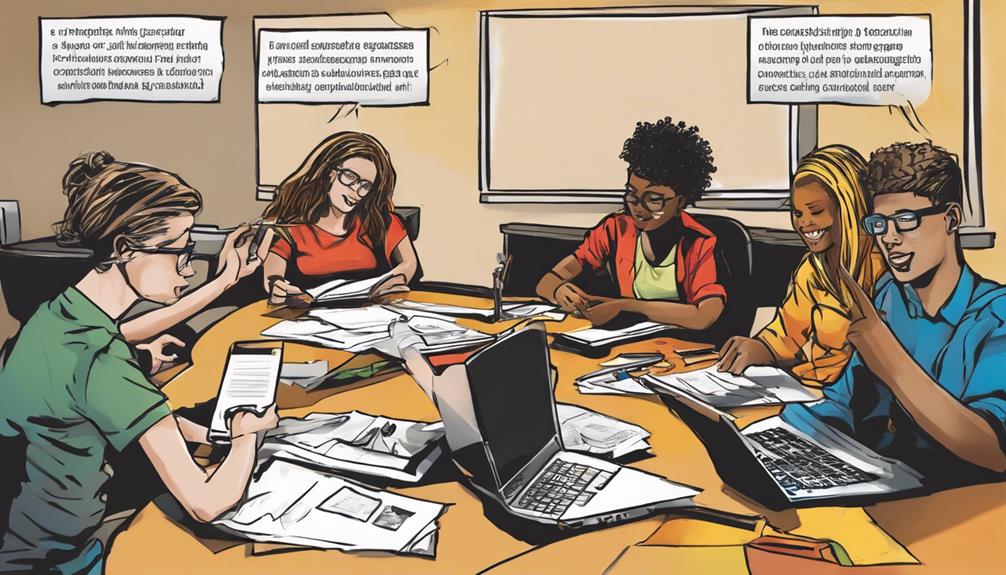Are you prepared to unveil four innovative strategies for enhancing your marking skills? Get ready for an exploration of live marking, which provides instant feedback using colorful pens that will surely capture your attention. Then, consider incorporating peer assessment to make collaboration more efficient and lighten your workload. Self-assessment will empower you to steer your learning journey and celebrate your achievements. Also, don’t underestimate the power of utilizing technology like Google Forms to simplify grading and save time. Intrigued? There is a plethora of marking techniques waiting for you, just a scroll away! It’s time to make your mark in the world of revolutionary marking!
Key Takeaways
- Implement live marking with colored pens for instant feedback.
- Utilize learning journals for weekly feedback and revision summaries.
- Introduce a Six-Step Peer Assessment System with clear mark schemes.
- Empower students with self-assessment checklists for assignments.
- Leverage technology for efficient grading using Google Forms and online quizzes.
Innovative Feedback Techniques

Improving student learning through innovative feedback techniques is essential for academic growth and improvement. One effective method is Live Marking, where you walk around with a colored pen, providing instant feedback.
Learning Journals are also fantastic – they help you summarize your revision and get weekly feedback.
Don't forget about Peer Assessment! It lightens the marking load and lets you hear from your classmates.
Remember, feedback should be specific and guide your learning journey.
And hey, have you tried the 'two stars and a wish' rule? It's a neat way to enhance feedback quality.
Enhanced Peer Assessment Methods

Consider incorporating a Six-Step Peer Assessment System with clear mark schemes and colored pens to enhance your peer assessment methods. This approach not only lightens your marking load but also fosters a collaborative learning environment where students actively engage in evaluating each other's work. By providing structured guidelines and using colorful pens to highlight areas for improvement, you're empowering students to give constructive feedback effectively.
Encourage students to focus on specific criteria and provide examples to support their evaluations. Monitoring the peer assessment process guarantees fairness and accuracy in grading. Utilize peer assessment for various tasks like correcting tests, homework, and assignments. With this method, students learn to assess work critically and develop essential evaluation skills for future success.
Empowering Self-Assessment Approaches

Enhance student engagement and learning outcomes through effective self-assessment strategies. Self-assessment is a powerful tool that allows you to take control of your learning journey.
By evaluating your own work, you gain a deeper understanding of your strengths and areas for improvement. Consider creating self-assessment checklists tailored to specific assignments or projects.
Reflect on your progress, set goals for growth, and celebrate your successes along the way. Embrace the opportunity to take ownership of your learning process and track your development over time.
Leveraging Technology for Efficient Marking

To streamline your marking processes and maximize efficiency, embrace the integration of technology for grading and feedback purposes. By leveraging tools like Google Forms and online quizzes, you can make assessment interactive and engaging. These platforms allow you to automate certain aspects of grading, saving you valuable time.
Additionally, spreading out marking days and setting realistic goals using technology can help you stay on top of assessments without feeling overwhelmed. Prioritizing marking based on student needs and learning objectives is made easier with the help of technology, ensuring that your feedback is timely and impactful.
Utilizing online resources and tools can revolutionize the way you approach marking, making the process more efficient and effective.
Strategic Time Management Practices

Embracing effective time management practices is essential for optimizing your marking efficiency and ensuring timely feedback for student progress. Prioritize tasks based on urgency and importance to make the most of your marking time.
Set specific time blocks for marking different assignments, and stick to them to maintain focus. Utilize tools like timers or apps to help you stay on track and avoid getting caught up in one task for too long.
Remember to take short breaks to refresh your mind and prevent burnout. By managing your time effectively, you'll not only meet deadlines but also have more time for yourself outside of marking.
Time management is the key to marking success!
Frequently Asked Questions
How Can Teachers Address Student Resistance to Feedback in Innovative Ways?
Address student resistance to feedback by fostering a positive learning environment through specific, emotional feedback. Encourage self-assessment for personal growth and utilize peer assessment to distribute workload and enhance feedback quality. Embrace technology for interactive assessment methods.
What Strategies Can Be Used to Ensure Fairness and Accuracy in Peer Assessment?
To guarantee fairness and accuracy in peer assessment, establish clear criteria upfront. Encourage students to provide constructive feedback aligned with set standards. Monitor the process to address any discrepancies promptly. Engaging students in this process fosters learning and collaboration.
How Can Self-Assessment Be Integrated Effectively Into Different Subjects and Grade Levels?
Integrate self-assessment effectively across subjects and grades by encouraging students to evaluate their work, identify strengths, and set improvement goals. Utilize tools like rubrics, past papers, and technology for efficient self-assessment tasks.
What Are Some Tips for Overcoming Technological Barriers in Implementing Efficient Marking?
Overcoming technological barriers in marking is key. Utilize tech tools like Google Forms for interactive assessments. Set realistic goals using technology for efficient marking. Prioritize tasks based on student needs and learning objectives, integrating technology for streamlined grading.
How Can Teachers Maintain a Balance Between Marking Efficiency and Personalized Feedback?
Maintaining a balance between marking efficiency and personalized feedback is key. Use live marking, learning journals, peer assessment, and effective feedback strategies. Prioritize student needs, implement time-saving tips, and leverage technology for efficient grading while still providing tailored feedback.
Conclusion
To sum up, by incorporating innovative feedback techniques, enhancing peer assessment methods, empowering self-assessment approaches, leveraging technology for efficient marking, and practicing strategic time management, you can truly transform your marking practices.
These key strategies won't only save you time but also elevate the quality of feedback and assessment in your classroom.
So why hesitate? Explore these cutting-edge approaches and unleash the full potential of your teaching journey today!










